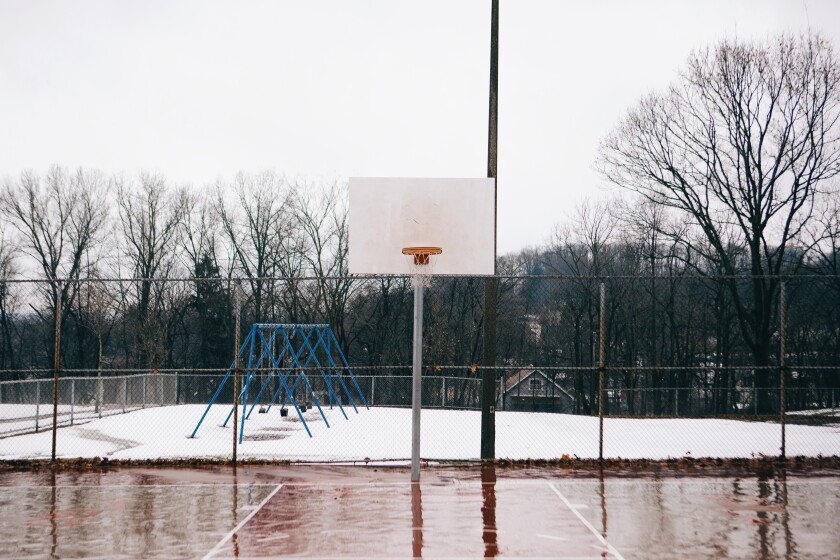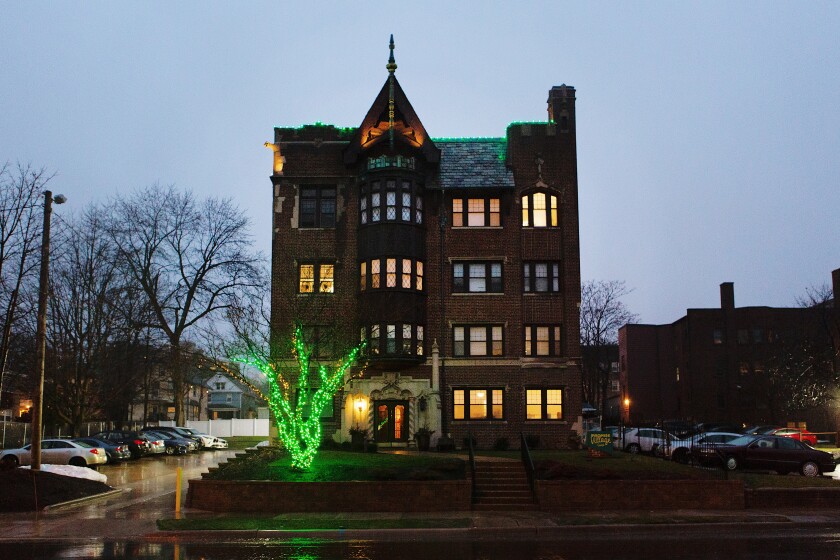LeBron James is saving Akron, even during NBA’s All-Star game
Lots of stories have been written about LeBron James and Cleveland.
About how, as a Cavalier, he came through for a city that had long ago soured on the possibility of winning a championship. And more recently, about how he’s still loved in The Land, despite decamping for life in Los Angeles as a Laker.
But I want to tell you a different story, this one about LeBron James and Akron.
About how, in addition to being the biggest booster of this proud but struggling city of roughly 200,000 people, he also is setting himself up to be its biggest savior — far more than most people realize.
But let’s begin at the beginning, at a gritty little basketball court 35 miles from the glitz of Rocket Mortgage FieldHouse in Cleveland.
While fans gathering for Sunday’s NBA All-Star game will undoubtedly see themselves as welcoming a wayward James “home,” it’s this court in west Akron that he never really left.

A LeBron James “Space Jam” mural in Akron, Ohio. The mural was painted by Kent State University art student Chardae Slater.
(Madeleine Hordinski / For The Times)
Tucked away in a tree-filled neighborhood park, it’s not on any official or unofficial sightseeing tour. Locals, for the most part, are only ones who know and care about it. In fact, it’s rather ugly.
The last time I saw it, during a trip home to northeast Ohio last summer, the hoops were bare of nets. The rose-colored playing surface was dull and chipped, probably as much from wear and tear as sun and snow. Empty bottles, discarded surgical masks, the butts of menthol cigarettes and the wrappers from corner-store cigars lined the bleachers.
The only sign of life was a group of men at a nearby picnic table, hooting and hollering in the eat-the-air humidity, while playing a spirited game of dominoes.
In 2005, though, this court was the place to be in Akron.
James, then finishing his second season with the Cavaliers, had brought in an MTV production crew to shoot “Battlegrounds: King of the Court.” The reality show, which he hosted, tracked two amateur teams — one led by former Chicago Bull Ben Gordon and the other by former Philadelphia 76er Andre Iguodala — and culminated in a three-on-three basketball tournament.
I was there that night, sitting on a friend’s porch across the street, watching as thousands of people jockeyed for a better view of celebrity players they never thought they’d see in real life. And they marveled at the court that Nike, at James’ urging, had paid to have resurfaced.

An empty basketball court in west Akron, Ohio, on Thursday. In 2005, LeBron James, then a Cleveland Cavalier, transformed the court at Perkins Park into a Hollywood set to film the final installment of a reality TV show.
(Madeleine Hordinski / For The Times)
“We’ve never had anything like this,” Scott Gooden, one of the officials in the tournament, told the Akron Beacon Journal at the time. “This is a great thing for Akron that LeBron is putting on, and it’s a lot of good publicity that we need.”
I was in my first year out of college, working at my first job in journalism. But I knew then, as I know now, that James had cemented his connection to the people of Akron that night. Particularly those who grew up Black and poor and traumatized like he did.
People who had been long ignored or betrayed by government and its systems walked away believing — if only for a moment — that they were important, had value, and were worthy of attention and investment.
But one-off events don’t bring about permanent change, as evidenced by the current condition of that west Akron basketball court and the surrounding neighborhood. That’s why I call this the beginning — not only of what the LeBron James Family Foundation has become, but what it is becoming.
The foundation’s executive director, Michele Campbell, explained it to me this way:
“The ‘I Promise’ movement was born after a lot of soul-searching and talking after that first year working in Miami and him coming home,” she said of James. “He was like, ‘We need to do more. We’re doing nice one-and-done events. But are we really moving a community? Are we really making a difference?’”
Most people know about his I Promise School, and the great success it has had in improving high school graduation rates and sending kids to college.
Most people don’t know about how his foundation has inserted into local government or how, at James’ direction, it is slowly pulling and transforming Akron’s bureaucracy to operate in the “I Promise” way.
“We feel that we’re modeling the way a community should operate,” Campbell explained, “and challenging — in very positive ways — how we change certain systems.”
::
Now before I go on, I’m sure some of you are wondering: Aren’t Cleveland and Akron basically the same place? The answer is — ahem — hell no. The cities are the seats of two different counties, and are about as different as Palmdale and Pasadena.
Cleveland, where I grew up, is known for its cutting-edge hospitals, museums, messy sports franchises (see Odell Beckham Jr.) and union-driven politics. In some ways, it is still trying to reinvent itself after losing the steel industry.
Akron lost its mojo when the rubber plants closed, but is still home to a lucrative polymers industry, as well as Devo, the All-American Soap Box Derby, the Black Keys and the Goodyear blimp. It’s also where Alcoholics Anonymous was founded, prompting thousands of people who have reclaimed their lives from addiction to descend on the city each summer in motorcycles. It’s very noisy.
James is a product of — well, kid from — Akron, not Cleveland.
Which is why, like the Akronite rubber barons before him who built Firestone Park and Goodyear Heights — neighborhoods for their workers that doubled as centers of power — he is basically building an “I Promise” neighborhood.
“If you look at history and look at what he’s doing, he’s taking a model that had worked and redoing it,” explained Judi Hill, president of Akron’s chapter of the NAACP.
In addition to the I Promise School, there is I Promise Village, I Promise Institute, I Promise Housing, along with Thirty Five Rhodes and, soon, House Three Thirty — an ode to Akron’s 330 area code. (More on that last one later.)

The I Promise Village, sponsored by the LeBron James Family Foundation, provides housing for students and their families who need an escape from homelessness, domestic violence or some other trauma.
(Madeleine Hordinski/For The Times)
All are clustered a mile or so from downtown Akron, mostly along one of the city’s main thoroughfares, West Market Street. And all were developed and now run on a mix of public and private capital, which James raised by leveraging his reputation.
“That kind of convening power doesn’t come with everybody,” Akron Mayor Daniel Horrigan said. “And he’s using it in a way that is always impactful for the city, in a positive way. He’s betting on us.”
In addition, the foundation has been quietly buying up land and commercial properties for future redevelopment along the same thoroughfare. That puts James in line with the increasingly popular strategy in Black America for revitalizing long-neglected neighborhoods.
But this part of the story is about more than just real estate. It’s about infiltration — Campbell’s word, not mine.
Rather than bypassing the broken government systems that James encountered growing up, his foundation is working with government so that future generations will have it better than he did.
For example, East Akron Neighborhood Development Corp. agreed to incorporate dedicated rooms for studying and a basketball court into the affordable complex that will be known as I Promise Housing.
“We’re doing this with the LeBron James Family Foundation, so you need a basketball court, because exercise is very important,” said Cheryl L. Stephens, chief executive of the public housing agency.
At the I Promise School, public school teachers are in classrooms, teaching a government- and union-approved modified curriculum on a modified calendar. Parents, meanwhile, have on-site access to a county-employed social worker, who can work out problems with accessing food stamps and other public assistance, as well as an in-house attorney who can offer advice on resolving custody cases and getting records expunged.
The so-called wraparound services model has worked so well that the United Way has replicated it at other schools across the city.
“If we created our own charter private school, we’d make all the rules,” Campbell said. “But how do you show others that you really can create change in a public school system? So that was like a directive from LeBron: We’re not creating our own. We’re working within.”
And in Akron, where city officials are swamped with challenges, they…
Read More: LeBron James is saving Akron, even during NBA’s All-Star game

